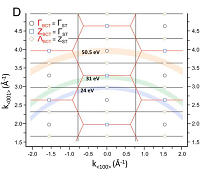Accueil > Équipes scientifiques > Surfaces, Interfaces, Molecules & 2D Materials (SIM2D) > Systèmes Fortement Corrélés et Matériaux Quantiques
Strongly Correlated Electron Systems and Quantum Materials
par - 1er juillet 2021 (modifié le 27 octobre 2021)
Strongly Correlated Electron Systems

Leader : Andrés Santander-Syro (MCF, HDR 2013, Junior Chair IUF 2011-2016) Participants : Emmanouil Frantzeskakis (MCF), Franck Fortuna (IRHC) Students : Maximillian Thees (PhD), Pedro Rezende-Goncalves (PhD - Belo Horizonte, Brazil) Previous members : Overview 1) Novel 2D electron systems at the surface of functional oxides 1) Novel 2D electron gases at the surface of functional oxides : 2) Exotic electronic states and phase transitions in correlated-electron materials : |
Techniques :
State-of-the-art high-resolution ARPES setup with low-temperature manipulator
XPS setup with monochromatic Al source
Molecular Beam Epitaxy chamber with LEED, RHEED, AES
Focussed-Ion Beam (FIB) (Plateform)
External Funding :
ANR projects LACUNES (PI) and Fermi-NESt (partner)
LabEx PALM projects ELECTROX (PI), 2DEG2USE (PI), and 2DTROX (PI)
Collaborations :
ISSP, University of Tokyo, Japan
IMRAM, Tohoku University, Japan
Hiroshima Synchrotron, Japan
University of California, San Diego
MagLab – University of Florida – Tallahassee
CNEA, Buenos Aires, Argentina
University of Würzburg, Germany
DIPC – University of the Basque Country, San Sebastián, Spain
C2N, CRISMAT, NEEL, LPS, SOLEIL
Highlights
|
article : E. Frantzeskakis, J. Dai, C. Bareille, T. C. Rödel, M. Güttler, S. Ran, N. Kanchanavatee, K. Huang, N. Pouse, C. T. Wolowiec, E. D. L. Rienks, P. Lejay, F. Fortuna, M. B. Maple, A. F. Santander-Syro. From hidden order to antiferromagnetism : Electronic structure changes in Fe-doped URu2Si2. PNAS 118, 2020750118 (2021).
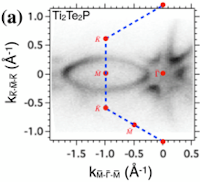 Experimental Observation and Spin Texture of Dirac Node Arcs in Tetradymite Topological Metals. We report the observation of a nontrivial spin texture in Dirac node arcs, i.e., novel topological objects formed when Dirac cones of massless particles extend along an open one-dimensional line in momentum space. We find that such states are present in all the compounds of the tetradymite M2Te2X family (M = Ti, Zr, or Hf and X = P or As) regardless of the weak or strong character of the topological invariant. The Dirac node arcs in tetradymites are thus the simplest possible textbook example of a type-I Dirac system with a single spin-polarized node arc. Experimental Observation and Spin Texture of Dirac Node Arcs in Tetradymite Topological Metals. We report the observation of a nontrivial spin texture in Dirac node arcs, i.e., novel topological objects formed when Dirac cones of massless particles extend along an open one-dimensional line in momentum space. We find that such states are present in all the compounds of the tetradymite M2Te2X family (M = Ti, Zr, or Hf and X = P or As) regardless of the weak or strong character of the topological invariant. The Dirac node arcs in tetradymites are thus the simplest possible textbook example of a type-I Dirac system with a single spin-polarized node arc.
|
article : J. Dai, E. Frantzeskakis, N. Aryal, K.-W. Chen, F. Fortuna, J. E. Rault, P. Le Fèvre, L. Balicas, K. Miyamoto, T. Okuda, E. Manousakis, R. E. Baumbach, A. F. Santander-Syro. Experimental Observation and Spin Texture of Dirac Node Arcs in Tetradymite Topological Metals. Phys. Rev. Lett. 126, 196407 (2021).
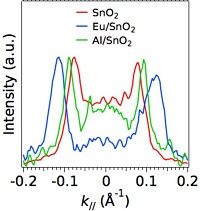 Tunable two-dimensional electron system at the (110) surface of SnO2. We report the observation of a two-dimensional electron system (2DES) at the (110) surface of the transparent bulk insulator SnO2 and the tunability of its carrier density by means of temperature or Eu deposition. The 2DES is insensitive to surface reconstructions and, surprisingly, it survives even after exposure to ambient conditions—an extraordinary fact recalling the well known catalytic properties SnO2. Our data show that surface oxygen vacancies are at the origin of such 2DES, providing key information about the long-debated origin of n-type conductivity in SnO2, at the basis of a wide range of applications. Furthermore, our study shows that the emergence of a 2DES in a given oxide depends on a delicate interplay between its crystal structure and the orbital character of its conduction band. Tunable two-dimensional electron system at the (110) surface of SnO2. We report the observation of a two-dimensional electron system (2DES) at the (110) surface of the transparent bulk insulator SnO2 and the tunability of its carrier density by means of temperature or Eu deposition. The 2DES is insensitive to surface reconstructions and, surprisingly, it survives even after exposure to ambient conditions—an extraordinary fact recalling the well known catalytic properties SnO2. Our data show that surface oxygen vacancies are at the origin of such 2DES, providing key information about the long-debated origin of n-type conductivity in SnO2, at the basis of a wide range of applications. Furthermore, our study shows that the emergence of a 2DES in a given oxide depends on a delicate interplay between its crystal structure and the orbital character of its conduction band.
|
article : J. Dai, E. Frantzeskakis, F. Fortuna, P. Lömker, R. Yukawa, M. Thees, S. Sengupta, P. Le Fèvre, F. Bertran, J. E. Rault, K. Horiba, M. Müller, H. Kumigashira, and A. F. Santander-Syro. Tunable two-dimensional electron system at the (110) surface of SnO2. Phys. Rev. B. 101, 085121 (2020).
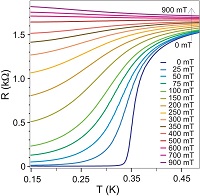 Gate-tunable superconductivity at SrTiO3 surface realized by Al layer evaporation. Electronic properties of low dimensional superconductors are determined by many-body-effects. This physics has been studied traditionally with superconducting thin films and in recent times with two-dimensional electron gases (2DEGs) at oxide interfaces. In this work, we show that a superconducting 2DEG can be generated by simply evaporating a thin layer of metallic Al under ultrahigh vacuum on a SrTiO3 crystal, whereby Al oxidizes into amorphous insulating alumina, doping the SrTiO3 surface with oxygen vacancies. The superconducting critical temperature of the resulting 2DEG is found to be tunable with a gate voltage with a maximum value of 360 mK. A gate-induced switching between superconducting and resistive states is demonstrated. Compared to conventionally-used pulsed-laser deposition, our work simplifies to a large extent the process of fabricating oxide-based superconducting 2DEGs. It will make such systems accessible to a broad range of experimental techniques useful to understand low-dimensional phase transitions and complex many-body-phenomena in electronic systems. Gate-tunable superconductivity at SrTiO3 surface realized by Al layer evaporation. Electronic properties of low dimensional superconductors are determined by many-body-effects. This physics has been studied traditionally with superconducting thin films and in recent times with two-dimensional electron gases (2DEGs) at oxide interfaces. In this work, we show that a superconducting 2DEG can be generated by simply evaporating a thin layer of metallic Al under ultrahigh vacuum on a SrTiO3 crystal, whereby Al oxidizes into amorphous insulating alumina, doping the SrTiO3 surface with oxygen vacancies. The superconducting critical temperature of the resulting 2DEG is found to be tunable with a gate voltage with a maximum value of 360 mK. A gate-induced switching between superconducting and resistive states is demonstrated. Compared to conventionally-used pulsed-laser deposition, our work simplifies to a large extent the process of fabricating oxide-based superconducting 2DEGs. It will make such systems accessible to a broad range of experimental techniques useful to understand low-dimensional phase transitions and complex many-body-phenomena in electronic systems.
|
article : Shamashis Sengupta, Emilie Tisserond, Florence Linez, Miguel Monteverde, Anil Murani, Tobias Rödel, Philippe Lecoeur, Thomas Maroutian, Claire Marrache-Kikuchi, Andrés F. Santander-Syro, and Franck Fortuna. Gate-tunable superconductivity at SrTiO3 surface realized by Al layer evaporation. J. Applied Physics 124, 213902 (2018).
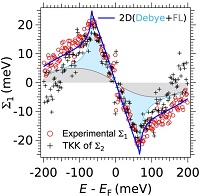 High-density two-dimensional electron system induced by oxygen vacancies in ZnO. We realize a two-dimensional electron system (2DES) in ZnO by simply depositing pure aluminum on its surface in ultrahigh vacuum and characterize its electronic structure by using angle-resolved photoemission spectroscopy. The aluminum oxidizes into alumina by creating oxygen vacancies that dope the bulk conduction band of ZnO and confine the electrons near its surface. The electron density of the 2DES is up to two orders of magnitude higher than those obtained in ZnO heterostructures. The 2DES shows two s-type subbands, that we compare with the d-like 2DESs in titanates, with clear signatures of many-body interactions that we analyze through a self-consistent extraction of the system self-energy and a modeling as a coupling of a two-dimensional Fermi liquid with a Debye distribution of phonons. High-density two-dimensional electron system induced by oxygen vacancies in ZnO. We realize a two-dimensional electron system (2DES) in ZnO by simply depositing pure aluminum on its surface in ultrahigh vacuum and characterize its electronic structure by using angle-resolved photoemission spectroscopy. The aluminum oxidizes into alumina by creating oxygen vacancies that dope the bulk conduction band of ZnO and confine the electrons near its surface. The electron density of the 2DES is up to two orders of magnitude higher than those obtained in ZnO heterostructures. The 2DES shows two s-type subbands, that we compare with the d-like 2DESs in titanates, with clear signatures of many-body interactions that we analyze through a self-consistent extraction of the system self-energy and a modeling as a coupling of a two-dimensional Fermi liquid with a Debye distribution of phonons.
|
article : T. C. Rödel, J. Dai, F. Fortuna, E. Frantzeskakis, P. Le Fèvre, F. Bertran, M. Kobayashi, R. Yukawa, T. Mitsuhashi, M. Kitamura, K. Horiba, H. Kumigashira, and A. F. Santander-Syro. High-density two-dimensional electron system induced by oxygen vacancies in ZnO. Phys. Rev. Materials 2, 051601 (2018).



